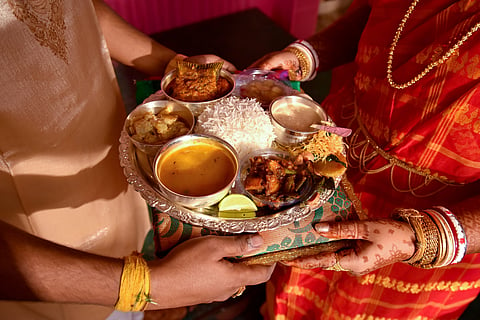Dining on discrimination: Caste is a vital hue that paints India’s culinary landscape
In India, food choices are not merely personal preferences but markers of social hierarchies. Despite several societal progress and affirmative actions these dynamics persist.
For instance, a recent article by the BBC proffers that 30 per cent of Indian children under five are stunted, with research indicating that children from socially privileged caste groups are 20 per cent less likely to experience stunting compared to those from marginalised communities.
This disparity underscores how access to quality nutrition and a conducive environment remains unequally distributed along caste lines, the recent debate sparked online by the introduction of the ‘pure veg fleet’ led to discomfort among the delivery executives, predominantly from marginalied communities.
To understand this complexity, one must delve into the historical and cultural roots of dietary preferences highlighting the entrenched role of caste in food practices.
From ancient scriptures like the Manusmriti to culinary texts such as Rasachandrika and Ishtann, food has long been a symbol of social order. The Brahminical emphasis on vegetarianism, rooted in the Vedic period, was initially a religious and cultural practice. Over time, it evolved into a marker of purity and dominance. The Dharmasutras, for instance, categorised foods as pure or impure, reinforcing caste hierarchies.
The origins of vegetarianism among Brahmins can be traced to territorial expansions in 5 CE when prohibitions on cow slaughter aligned with their need for cattle during long-distance travels.
Meanwhile, marginalised communities, particularly Dalits, relied on readily available foods, including meat that were often deemed ‘impure’ by upper castes. This divide solidified over centuries, shaping dietary practices that persist today.
Intracommunity variations
Even within Brahmin communities, regional variations exist. Brahmins in North India often avoid onions and garlic, while their counterparts in Odisha and West Bengal consume fish as a sacred food. West Bengal’s culinary landscape, dominated by fish and rice, starkly contrasts with vegetarian strongholds like Gujarat and Rajasthan, where societal norms discourage meat consumption.
According to a Pew Research survey, four in 10 Indian adults identify as vegetarians, with higher proportions in Western (57 per cent) and Northern (71 per cent) regions, compared to the East (18 per cent) and Northeast (19 per cent).
Religious observance also plays a crucial role. Highly religious Hindus are more likely to follow vegetarian diets.
However, even among vegetarians, caste-based biases persist. Surveys reveal that 51 per cent of Hindus and 72 per cent of Jains avoid eating food prepared by individuals from different religious or dietary backgrounds. Such practices perpetuate the idea of ‘purity’ associated with vegetarianism, often excluding those from marginalised communities who consume meat.
Dalit culinary traditions, shaped by survival and economic necessity, highlight this exclusion. Historically, Dalits consumed millets, broken corn, and other foods deemed ‘lowly’ by upper castes. Their diets, born out of resource constraints, contrast sharply with the dairy and ghee-rich diets of upper castes.
These distinctions are further reinforced by societal norms that prioritise ‘pure’ vegetarian food in public spaces like temples and restaurants, where cooks are predominantly upper-caste males.
Equating vegetarianism with moral superiority
The infrastructure of casteism clearly manifests in food practices, where vegetarianism is elevated as a marker of moral superiority.
For instance, in inter-caste marriages, food becomes a battleground of cultural assimilation, with women from marginalised communities often forced to adopt the dietary practices of upper-caste families. Such dynamics underscore the patriarchal and caste-based underpinnings of Indian society.
It is important to recognise that dietary preferences, in themselves, are not harmful. The issue arises when these preferences are weaponised to exclude or demean others. The concept of ‘pure veg’ is particularly problematic, as it aligns with caste hierarchies that view meat-eating as impure and associate it with marginalised groups.
Scholars like Dolly Kikon have highlighted how casteism categorises food cultures as clean or dirty, reinforcing social stratification.
The Hindu dietary code, closely tied to religious observance, reflects these biases. For instance, 46 per cent of Hindus who prioritise religion report being vegetarian.
Sub-altern scenario
Among Dalits, however, meat remains integral to their diets, reflecting centuries of adaptation to economic and social constraints. This divergence illustrates how food practices are not merely about individual choice but are deeply intertwined with historical injustices and power structures.
The preference for vegetarianism among affluent castes often extends to avoiding root vegetables or dining at places where vegetarian and non-vegetarian food coexist. This exclusionary behaviour marginalises those who do not conform to such norms, perpetuating caste hierarchies under the guise of dietary choices.
To address these disparities, it is crucial to challenge the narrative that elevates vegetarianism as morally or culturally superior. Public spaces and institutions must actively promote inclusivity in food practices, ensuring that marginalised communities are not excluded or stigmatised. Recognising the diversity of India’s culinary traditions is essential to dismantling caste-based prejudices embedded in food.
Food, while a basic human need, is also a powerful symbol of identity and social order. By acknowledging and analysing the caste dynamics inherent in Indian dietary practices, one must question how such initiatives could deepen social and religious divides in a country already marked by its diversity.
Could this pave the way for further polarisation in how food practices shape inclusion or exclusion in India’s socio-cultural fabric?
Views expressed are author’s own and do not necessarily reflect those of Down To Earth

